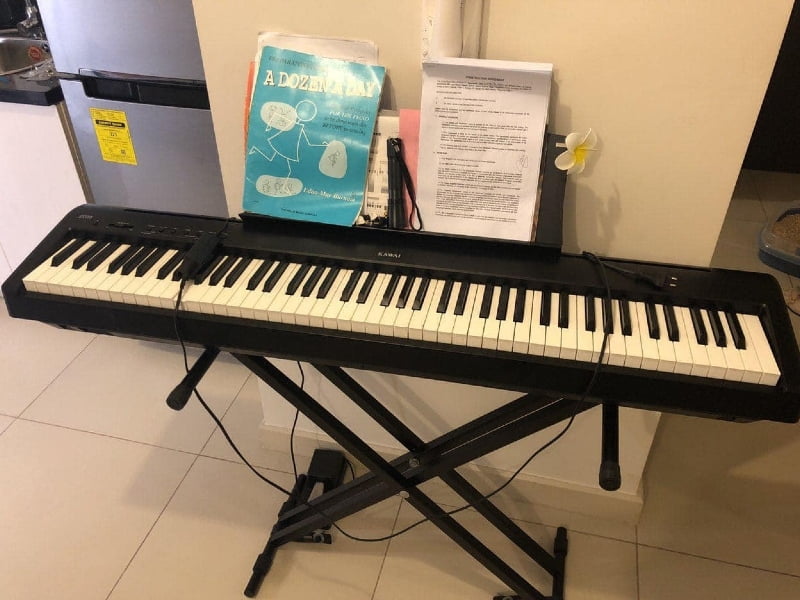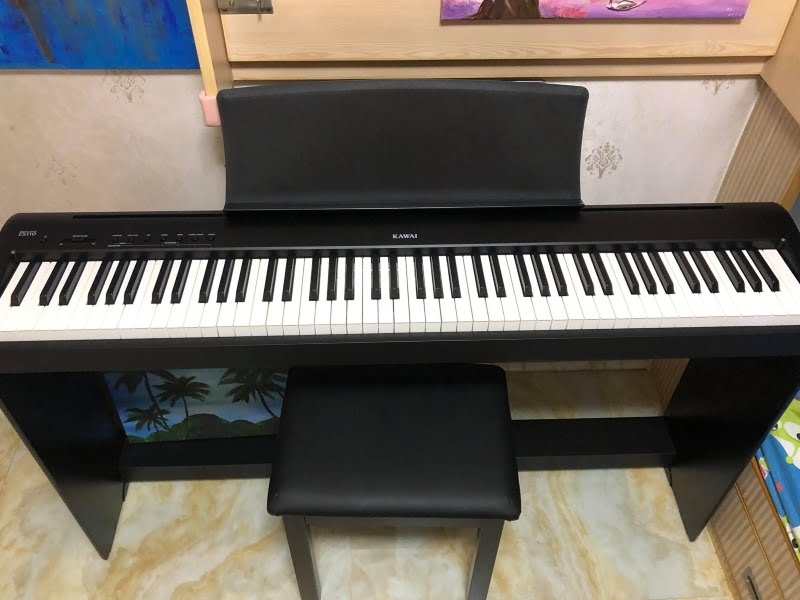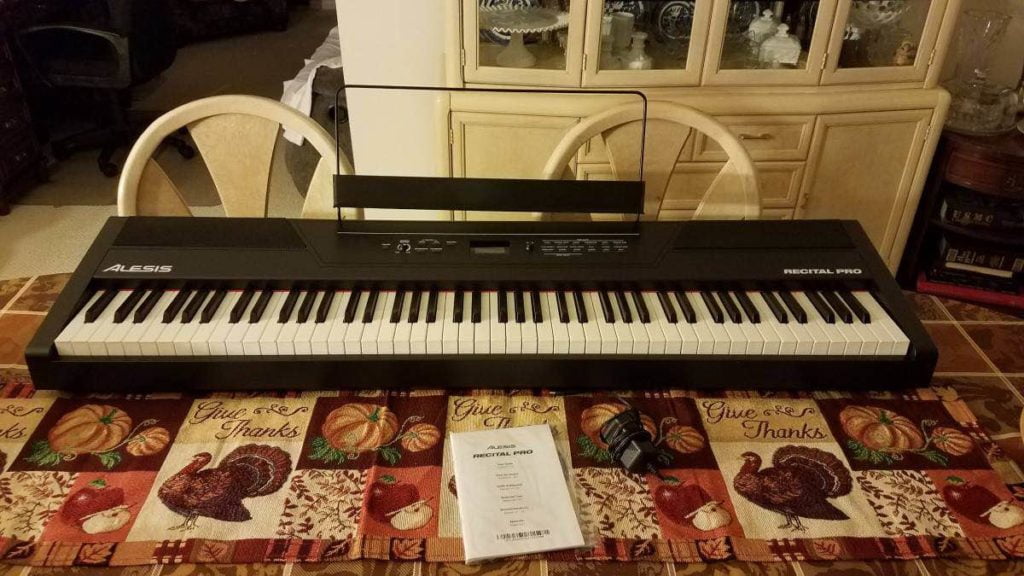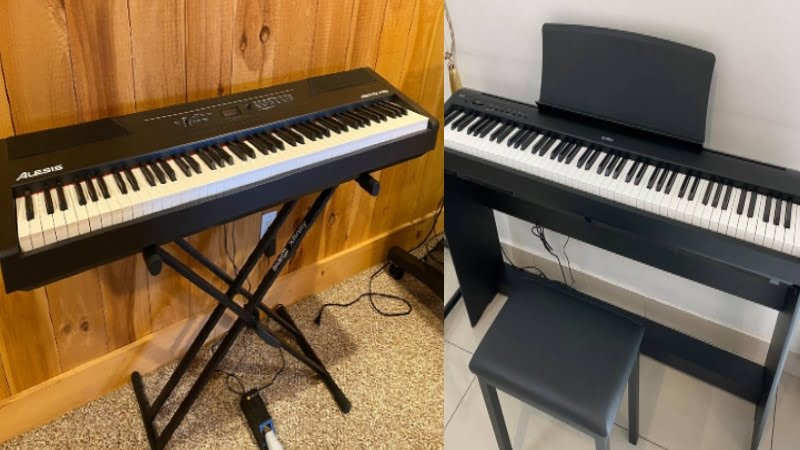Find the best digital piano for your needs in this Kawai ES110 vs Alesis Recital Pro comparison.
The Kawai ES110 has been dubbed the king of budget digital pianos. And once you see this piano’s features and its price point, it’s easy to see why.
That said, this Kawai model is still a bit more expensive than other pianos we consider “budget-friendly”. For example, the Alesis Recital Pro is considerably more affordable than the Kawai but comes with a similar feature set.
So, is the Kawai ES-110 really worth your money?
Well, when making this Kawai ES-110 vs Alesis Recital Pro comparison, I found out that it is. Even if it’s a bit more expensive, it comes with premium features that you usually find in more expensive pianos. And while the Alesis Recital Pro put up a good fight, it couldn’t beat out the value for money that the Kawai ES-110 offers.
I’ll get into the details of both pianos in today’s comparison. That way, you’ll have an easier time choosing the best piano for your needs!
Kawai ES110 vs Alesis Recital Pro: Comparison Chart


Last update on 2025-07-11 / Affiliate links / Images from Amazon Product Advertising API
Kawai ES110 vs Alesis Recital Pro: A Head-to-Head Comparison
I tested all the main features of the Kawai ES-110 and the Alesis Recital Pro. And by the end, the score was 3-1 in favor of the Kawai. The Recital Pro was able to put up a decent fight in almost all categories. However, there’s a reason the Kawai ES-110 is one of the best-rated digital pianos in this price range.
Feel & Playability
The winner: Tie
One of the most important features when buying a digital piano is the feel. These pianos are more expensive than a typical keyboard because they’re designed to replicate an acoustic piano. So, make sure that you spend your money on a digital piano that feels close to a digital piano.
Luckily, both of these instruments feel close to acoustic pianos. They come with advanced hammer action systems that you wouldn’t expect in this price range. So, they both won the point in this category.

+Hammer Action
The Alesis Recital Pro uses fully-weighted keys. Usually, pianos in this price range only come with semi-weighted keys, so it was quite a surprise. On top of that, I noticed a really realistic weight on the keys, which I wasn’t expecting. So, the Alesis Recital Pro is a great pick if you want a piano with decent hammer action at a low price point.
That said, the Kawai ES-110 has a more sophisticated hammer action system, which you’d expect since it’s the more expensive model. This piano uses a responsive hammer action system which you can also find on premium Kawai pianos. This is a springless hammer action system that offers a very realistic touch.
And while both pianos do a great job, I feel like they were lacking in the subtle weight differences that you have on an acoustic piano. This is because neither piano has a graded hammer action system which was a slight letdown.
Additionally, since these are on the more affordable end of the spectrum, they also use glossy plastic keys. Having textured keys would have been a huge difference-maker for either piano, but none of them come with this feature.
Tone
The winner: Kawai ES110
Arguably, tone is the most important aspect of a digital piano. You never want to spend money on a digital piano that sounds digital. There are many digital pianos nowadays that have a very realistic tone, like the Kawai ES110 and the Alesis Recital Pro. But since the Kawai ES110 had a wider sound library, it ended up winning the point.
+Tone Generation
Both of these pianos generate tones through samples. These pianos come loaded with sample recordings of various instruments. And whenever you press a key on the piano, you trigger one of these samples.
This is one of the simplest tone-generation methods, but both Kawai and Alesis do a great job. This is because these pianos utilize multi-layered samples. These samples create a more detailed tone that sounds very close to the real thing.
Granted, you can still feel that the sounds come from a digital piano. But for entry-level pianos, both instruments surpass their price range’s expectations.

+Sound Library
The main reason the Kawai ES110 won out when I compared the tones of both pianos was the sound library. Most digital pianos have a limited sound library, and these instruments are no exception. However, you still have more sound options on the Kawai compared to the Alesis.
The Alesis comes pre-loaded with 12 voices. This includes a selection of acoustic and electric piano tones, strings, organ, and bass sounds. As a beginner, these are all the tones you need, and it’s nice that there’s some variety in your options.
That said, the Kawai takes it a step further. This piano comes in 16 tones. And while this isn’t that much more than the Alesis Recital Pro, it offers much more variety. So, if you want to have full control over your tone and how you sound when playing the piano, the Kawai ES110 might be the better pick.
Piano Features
The winner: Kawai ES110
The last comparison point I had for these two pianos was the piano features. And one of the reasons the Kawai ES110 is more expensive is that it has better piano features than the Alesis Recital Pro. With better polyphony and more realistic effects, the Kawai ES110 easily won this comparison.
+Effects
The Alesis Recital Pro comes with more effects than the Kawai ES110. However, the Kawai ES110’s effects are much more realistic than the Recital Pro’s. The Recital Pro has reverb, chorus, and modulation effects. And while these are fun to play around with, they aren’t the most realistic, and you’re likely only going to use the reverb effect when on stage.
The Kawai ES110, however, comes with a great reverb and brilliance effect. If you’re a performing pianist, this is a great set as you get full control over your tone. With reverb, you can add depth and character while changing the tone’s shape and brightness with the brilliance effect.
+Polyphony
For a budget-friendly digital piano, the Recital Pro has decent polyphony. With 128-note maximum polyphony, you can add a lot of emotion to your playing by stepping on the sustain pedal and hearing your notes ring out with great clarity. Most pianos in this price range have 64-note polyphony which means you can be much more expressive with the Recital Pro.
That said, the Kawai ES110 comes with 192-note polyphony. This makes a huge difference and is why even novices and some performing pianists enjoy using this model. You won’t find pianos with more polyphony in this price range, and this is one of the key reasons the Kawai ES110 is one of my favorite models on the market.

Kawai ES110 vs Alesis Recital Pro: The Similarities
It may come as a surprise, but these pianos actually have their fair share of similarities. To start, the Kawai ES110 and Alesis Recital Pro are both portable digital pianos. This is great for beginners and pianists on the go as you can easily bring either model with you to rehearsals, lessons, and gigs.
On top of that, the pianos have the same set of playing modes. You can utilize dual mode to layer two different voices on top of each other and duo mode to divide the piano into two mini keyboards. These are great features for beginners and novices alike.
And while they fall under the same price range, the Kawai ES110 comes out on top. If you’re looking for more tonal variety and more piano features, the Kawai ES110 easily wins in this comparison. But if you’re on a tight budget, there’s nothing wrong with the Alesis Recital Pro either.
Quick Rundown of the Kawai ES110
- 88-key Digital Stage Piano with Responsive Hammer Compact Action
- Built-in Stereo Speaker System
- Bluetooth MIDI pts
- 192-note Polyphony
- Dual Split Modes
Last update on 2025-07-11 / Affiliate links / Images from Amazon Product Advertising API
Quick Rundown of the Alesis Recital Pro
- A Digital Piano That’s Tailored to You - Feature-packed electric keyboard with 88 premium full-sized weighted hammer action keys with adjustable touch response to suit your preferred playing style
- Premium Sounds - 12 voices (Incl. Acoustic Piano, Electric Piano, Organ, Synth, and Bass), built-in FX: Chorus, Modulation, Reverb, and two built in 20W speakers for clear, room-filling sound
- All The Right Connections - ¼” sustain pedal input (pedal not included), ¼” stereo headphone output for private practice and stereo outputs for connection to speakers / amplifiers
- Play the Keyboard Wherever You Go - Power via the included power adapter or 6 D cell batteries (not included) for professional piano performance anywhere
- Powerful Educational Features - Standard, split, layer, record and lesson modes with 128-note max polyphony and Skoove 3 month premium subscription for expert interactive online piano lessons
Last update on 2025-07-11 / Affiliate links / Images from Amazon Product Advertising API
Product Videos
Related Articles to Kawai Es110
- Casio PX-770 vs Kawai ES-110: Should You Get A Portable or Console Digital Piano?
- Yamaha P125 Vs Kawai ES110 Comparison: Which Is The Best Portable Digital Piano
Related Articles to Alesis Recital Pro
- Alesis Recital Pro vs Williams Legato III: Discover the Best Piano for Your Home
- Alesis Recital Pro vs Roland Go Piano 88 Comparison: Which Is The Best Portable Digital Piano?
- Alesis Recital Pro vs Yamaha NP32 Comparison: Discover the Best Piano for Your Home
- Alesis Recital Pro vs Prestige Comparison: Choosing the Best Entry-Level Alesis Piano
- Alesis Recital Pro vs Casio CDP-135: Which Is the Best Beginner’s Digital Piano?
- Alesis Recital Pro vs Roland FP-30: Finding the Best Digital Piano on a Budget
- Alesis Recital Pro vs Casio CDP-S150 Comparison: Which Is The Best Portable Digital Piano?
- Alesis Virtue vs Recital Pro: Which Piano Offers The Most For Beginners?
- Alesis Recital Pro vs Casio PX 160: Which Piano Comes Out On Top?
- Alesis Recital Pro vs Roland FP 10: Why You Should Go For The Alesis Recital Pro
- Alesis Recital Pro vs Korg B2 Comparison: Which Digital Piano Should You Get?
- Alesis Recital Pro vs Williams Allegro 3 Comparison: Which One Is Worth Your Money?
- Alesis Recital Pro vs Yamaha P125 Comparison: Which Is The Best Portable Digital Piano?
- Alesis Recital vs Alesis Recital Pro: Should You Invest In The Recital Pro?
- Alesis Recital Pro vs Yamaha P45: Which Should You Get As Your First Piano?
- Donner DEP-20 vs Alesis Recital Pro Comparison: Two Great Pianos Designed for Beginners
- Alesis Prestige Artist vs Recital Pro: Which Is the Best Alesis Piano for Beginners?
- Yamaha P71 vs Alesis Recital Pro: Which Digital Piano is the Best Option for Beginners?
References:
- Kawai ES110: https://www.kawai-global.com/product/es110/
- Alesis Recital Pro: https://www.alesis.com/products/view/recital-pro
Lulacruza is an electronic folk duo operating at the junction of the hypermodern and the ancient. Our music weaves together hypnotic female singing, South American folk instruments and electronic processing, while channeling pulsating waves from the source of creation.
Lalucruza is also a community where you can connect with other music lovers to collaborate, exchange ideas and share knowledge. A platform for who wants to learns the basics of playing piano, guitar, drum masters’ technique, etc.. is the premise of our website.
